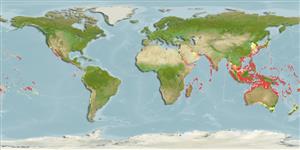Common names from other countries
>
Gobiiformes (Gobies) >
Gobiidae (Gobies) > Gobiinae
Etymology: Eviota: No etymology given, suggested by Christopher Scharpt: from Latin 'eu' for 'true' and 'iota' for anything very small, in combination 'truly very small' referring to it as being the smallest vertebrate at the time it has benn described by Jenkins (thus, making the suggestion by Scharpt plausible..
More on author: Klunzinger.
Environment: milieu / climate zone / depth range / distribution range
Ekologi
laut berasosiasi dengan karang; kisaran kedalaman 0 - 65 m (Ref. 86942). Tropical
Indo-West Pacific: East Africa, including the Red Sea; throughout East Indian region, including Indonesia, Philippines, Palau; north to southern Japan, south to Lord Howe and Norfolk Island (but not known from the Great Barrier Reef).
Size / Weight / umur
Maturity: Lm ? range ? - ? cm
Max length : 3.1 cm SL jantan/; (Ref. 1602)
deskripsi pendek
Kunci identifiaksi (pengenalan) | Morfologi | Morfometrik
Duri punggung (Keseluruhan (total)) : 7; duri punggung lunak (Keseluruhan (total)) : 8 - 11; Duri dubur: 1; Sirip dubur lunak: 7 - 9. Characterized by 5 subcutaneous spots from anal base to caudal base (Ref. 2798); translucent greenish color with 6-7 internal brown bars; scale margins reddish brown; head with red-brown spots/bands; upper half of caudal peduncle with large black spot; prolonged and filamentous first dorsal spine in male; longitudinal scale series 23-25; ctenoid scales, absent on head, nape, breast and pectoral fin base; separated pelvic fins, thin membrane joining bases; depth of body 4.1-5.0 in SL (Ref. 90102).
Inhabits rubble and algal-covered dead reef near shore in 0-5 m (Ref 90102).
Life cycle and mating behavior
Maturities | Reproduksi, perkembang biakan | Spawnings | Egg(s) | Fecundities | Larva
Myers, R.F., 1991. Micronesian reef fishes. Second Ed. Coral Graphics, Barrigada, Guam. 298 p. (Ref. 1602)
Status IUCN Red List (Ref. 130435)
CITES (Ref. 128078)
Not Evaluated
ancaman kepada manusia
Harmless
penggunaan manusia
Alat, peralatan
laporan khas
muat turun XML
Sumber internet
Estimates based on models
Preferred temperature (Ref.
115969): 24.5 - 29, mean 27.7 (based on 1138 cells).
Phylogenetic diversity index (Ref.
82804): PD
50 = 0.5000 [Uniqueness, from 0.5 = low to 2.0 = high].
Bayesian length-weight: a=0.00708 (0.00333 - 0.01504), b=3.09 (2.92 - 3.26), in cm Total Length, based on LWR estimates for this (Sub)family-body shape (Ref.
93245).
Trophic level (Ref.
69278): 3.1 ±0.3 se; based on size and trophs of closest relatives
Daya lenting (Ref.
120179): Tinggi, Waktu penggandaan populasi minimum kurang dari 15 bulan (Preliminary K or Fecundity.).
Fishing Vulnerability (Ref.
59153): Low vulnerability (10 of 100).
